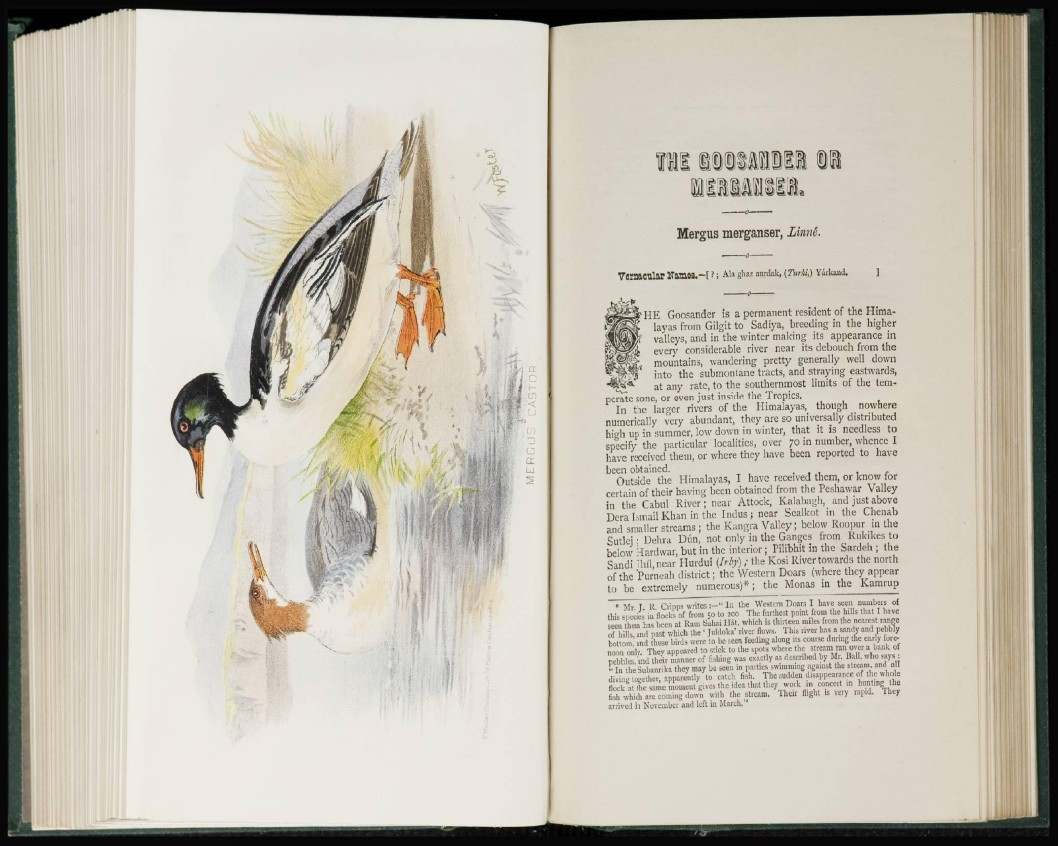
r- tit < *
\ 11 • f:
TOI l i l l â l i i l 1 1
illlâïïlia
Mergus merganser, Linné.
Vernacular lTamôS.-[ ? ; Ala ghaz aurdak, {Turk',) Yârkand. ]
HE Goosander is a permanent resident of the Himalaj'as
from Gilgit to Sadiya, breeding in the higher
valleys, and in the winter making its appearance in
every considerable river near its debouch from the
mountains, wandering pretty generally well down
into the submontane tracts, and straying eastwards,
at any rate, to the southernmost limits of the temperate
zone, or even just inside the Tropics.
In the larger rivers of the Himalayas, though nowhere
numerically very abundant, they are so universally distributed
high up in summer, low down in winter, that it is needless to
specify the particular localities, over 70 in number, whence I
have received them, or where they have been reported to have
been obtained.
Outside the Himalayas, I have received them, or know for
certain of their having been obtained from the Peshawar Valley
in the Cabul River; near Attock, Kalabagh, and just above
Dcra Ismail Khan in the Indus ; near Sealkot in the Chenab
and smaller streams ; the Kangra Valley; below Roopur in the
Sutlcj ; Dehra Dun, not only in the Ganges from Rukikes to
below Hardwar, but in the interior ; Pilibhit in the Sardeh ; the
Sandi Jhil, near Hurdui {Irhy) ; the Kosi River towards the north
of the Purneah district; the Western Doars (where they appear
to be extremely numerous)*; the Monas in the Kamrup
* Mr. J. R. Cripps writes " In the Western Doars I have seen numbers of
this species in flocks of from 50 to 200 The furthest point from the hills that I have
seen them has been at Rani Sahai Hat, which is thirteen miles from the nearest range
of hills, and past which the ' Juldoka' river flows. This river has a sandy and pebbly
bottom, and these birds were to be seen feeding along its course during the early forenoon
only. They appeared to stick to the spots where the stream ran over a bank of
pebbles, and their manner of fishing was exactly as described by Mr. Ball, who says :
" In the Subanrika they may be seen in parties swimming against the stream, and all
diving together, apparently to catch fish. The sudden disappearance of the whole
flock at the same moment gives the idea that they work in concert in hunting the
fish which are coming down with the stream. Their flight is very rapid. They
arrived in November and left in March."